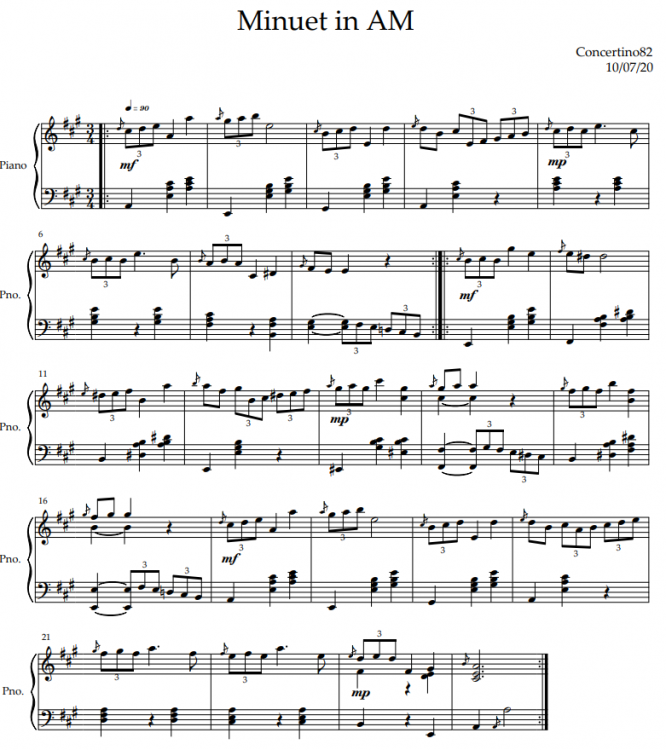Leaderboard
Popular Content
Showing content with the highest reputation on 08/09/2020 in all areas
-
Good evening everyone, I am excited to present a new piece I have been working on: "Sinfonietta No. 2 for Large Orchestra". I have been working on this piece since last December (with a few interruptions due to the pandemic and life in general) and just added the finishing touches this last week. I chose what you might call an "extended" sonata form, with a longer introduction, exposition of two themes, development, recapitulation, and resolution/coda. I am interested in any and all constructive feedback. Since I just completed this piece, I'm very interested and open to ideas on how it could be improved. Like my last work, it is a little long clocking in around 20 minutes, so I broke it up into "chunks" if you want to listen a little bit at a time: (0:00 - 4:12) Introduction (0:00 - 1:33) A piercing opening that leads into a stormy "Infernal" theme (1:33 - 3:48) An ominous theme that leads into a passionate proclamation (3:48 - 4:12) - Brief return of the opening theme (4:12 - 5:48) Exposition of Theme A, a thundering overflow of aggression (5:48 - 6:32) Brief Transition from Theme A to Theme B (6:32 - 8:19) Exposition of Theme B, a wandering chromatic theme underscored by a heavy ostinato (8:19 - 14:03) Development, referencing and expanding the themes above, while deriving a few new ideas from the themes as well (14:03 - 15:35) - Recap of Theme A, transposed (15:35 - 16:00) - Brief Transition form Theme A to Theme B (16:00 - 17:45) - Recap of Theme B, transposed (17:45 - 20:18) - Resolution/Coda, a somewhat impatient, but ultimately triumphant finale As you listen, there are a few things I would like to hear your opinions on: What effect does the music have on you? Does in conjure up an image? Or an emotional feeling? Does it tell you a story? This can be the piece as a whole, or a specific part or parts. What was your favorite part? What was your least favorite part? Do you have any comments or critiques on technique, e.g. harmony, melody writing, counterpoint, orchestration, voice-leading, etc.? How do you feel about the overall form? Is it effective? Do any of the parts seem impractical to you? I tried to challenge myself with this piece and as a result I wonder if I pushed the expectations of some of the instruments too far. For example, I included "optional" Eb and D clarinet parts for some of the higher clarinet parts, but I'm not sure if it was necessary. I'm also not sure if some of the string technique in Theme A and the "Infernal" section is practical or not. Do any clarinet players or string players have any insight? Do you have any comments of the quality of the performance in the audio file? I really want this to be a decent representation of how the piece would sound if it were performed live, since it is unlikely it ever will be. For example "I would have liked xxx instrument to be louder/softer here" or "The xxx instrument technique sounds sloppy here and could use some cleaning up" or "The balance in the xxx section was all out of proportion" I have included a score and welcome any constructive feedback on its presentation. And if you're like me it's a lot more fun to follow along with the score. Do you think "Sinfonietta" is a appropriate designation, or would you call it something else? If you could name this piece, what would you name it? Thanks for listening and I hope you enjoy! As always, if you liked something I did and want me to explain how I did it I am happy to do so. Or if you just want to tell me it's awful that's fine too. gmm4 points
-
Hi everyone, For those who don't know me my name is Camille, I'm French and I'm 17 years old. I'm familiar with classical music and orchestral litterature and I often compose for piano and orchestra. These last 3 months I composed a piano concerto in C minor. This is my big project of the moment and also the one that took me most time to compose. I create this topic to share the first movement of this piano concerto. It lasts about 17 minutes and follow a strict sonata form. I took the habit to compose a piano concerto per year and this is what I consider my most accomplished piece so far. Here is below the score and the audio. Enjoy the music, and, please, tell me your opinion about this composition. STRUCTURE OF THE MOVEMENT : INTRODUCTION : M. 1-31 (Moderato, TEMPO I) : Orchestral introduction, statement of the first “theme” on cellos and violas. Dramatic crescendo until the piano entrance M 31-39 : brief piano cadenza allowing the listener to be more familiar with the main theme/material of the piece. Little arpeggios … EXPOSITION: M. 40 – 76 (Allegro) : This is the one ! After a short motif used later in the concerto (in the cello/bass part) statement of the THEME 1 A (violins parts) that as been stated in the introduction. Repeated in piano part m.57. The reappearance of theme 1A leads to a dramatic climax m.70 (being the continuity of 1A). M. 77 – 120 (Vivace) : THEME 1 B. Much faster, this theme consists of a repeated eight-notes pattern in the woods. The piano responds with an avalanche of sixteenth notes. Until m.120, strings are an accompaniment. Main motives are stated in the woods (such as the motif m99, flutes and oboes, it will appear later in the development). The pianist is showing is virtuosity in his modulating part and is assisting the orchestra. M17-20 : end the of first theme with a frenetic climb. M 120-127 : Transition to THEME 2. The piano part is quoting 1A and the clarinets are stating a thematic material of transition later used in the development. The rhythm seems to slow down allowing a quasi-cadenza in piano part (m127) leading to… M 128-150 (Andante) : THEME 2A. Lyrical theme (piano part) that appears 3 times, each one being richer in accompaniment and chord. The 3rd one is introduced by the clarinet material OF m120-127. M 150-169 : THEME 2B : consisting (mainly) of one quarter note and six descending quavers. Again, a virtuosic piano and a support orchestra merges and form a whole for this 2B. M 170-184 : Return of THEME 2A but in a heroic climax where the piano supports the orchestra with arpeggiated chords. Transition with big orchestra chord until… M. 185-194 : ENDING OF EXPOSITION : Theme 2A and 2B are combined but in a the minor key of C to allow the arrival of … DEVELOPMENT: M. 195 – 215 : A repetition of the orchestral introduction with a few small things arranged to lead to the development M. 215 – 250 : Basically THEME 1A is all over the place, dissected, disguised, modulated. Have fun trying to count how many times it appears, you will be wide of the mark lol (You’ll notice, by the way, the transition theme M247, clarinets). M. 251 : 266 : Same thing as m215-250 but with THEME 1 B. M. 267-280 : mish-mash of T1A and T1B leading to CADENZA: M 280-323 : The cadenza is divided in two parts each one being a recapture of T1A. One is aggressive and fast while the other must be played maestoso. M 323-337 (En ralentissant tempo T2) : THEME 2 A being stated in the form of a bucolic love letter leading to M. 339 – 350 (Tempo I) : orchestral introduction allows the arrival of : RECAPITULATION: M. 350 – 383 : THEME 1A is repeated with a long piano speech of with what I called earlier the “continuity of” 1A. M.384 – 404 : THEME 1B (modulations, few changes + new clarinet melody) + transition theme leading to M 405 – 417 : Small piano cadenza, this one could be improvised by the pianist ! Statement of THEME 2 A with big and dramatic piano chords helping the orchestra to achieve the tragic of the moment. M 418 – 421 : THEME 2 B faster and faster. CODA : M. 422 - END (Vivace) : Using of T1A with virtuosic piano passages and symbiosis between soloist and orchestra until the end.1 point
-
First part of a short sonatina. Called arcaica (ancient) because it uses modes, but also PC set techniques. Played live.1 point
-
This is a reconstruction of the first movement of Mozart’s Symphony 42. The manuscript was discovered under the sound board of an old harpsicord sent in for restoration. As is well known, Mozart was always hiding his manuscripts as he knew Salieri was always sniffing around nicking his tunes but this manuscript was thought lost. The manuscript appears to be a rough draft. There are inconsistencies in the musical style. A diary note left by Mozart tells us why. Approximately translated from German it reads: “After a harrowing half hour with my teetotal publisher I had lunch with Donizetti in Sleazy Ed’s Timetravel café next to Die Letzte Möglichkeit (Last Option) Bordello down Vienna High Street. He wants to borrow my coloratura and mistress for his new opera, the Magic Fruit. I held out until he offered me 100 bottles of Schnapps. But for the Apfelstrudel being too salty it was a pleasant lunch. We exchanged many ideas. I like his style so I may entertain some of his ideas in this new symphony. He’ll think I lifted them from his Lucia, a nice piece. A shame that we’re too early for films. He’d be rich. We both would. He also smells better than Brahms who has birds nesting in that horrid beard. Brahms is always complaining about how that ivory-tickler B. Toven left him redundant. Gaetano and I laughed over Brahms challenging me to billiards. The man really doesn’t know what to do with his balls. Gaetano has promised to send the recipe for Neapolitan Sixths which I can’t wait to add into the symphony.” ©Dr P Yano So here is the reconstruction. Performed by the Sinfonia Cacophonica of Burana.1 point
-
Hi everyone! This is the 3rd movement of my string quartet! In contrast to the meandering 2nd movement which does not have any structure, this movement is mostly following the Rondo form, and I used motifs extensively throughout the piece. This was also the first time where I tried using parallel motion for the theme and climax of the movement to contrast the episodes which are more polyphonic and uses more call-and-response. I also included a quasi cadenza for the cello before the reprisal back to the opening of the piece, with a fiery cadenza to end the piece! Let me know what you guys think and feel free to feedback in the comments! Thank you for taking the time to listen!1 point
-
Hi @gmm, just wanted to drop in on my first listen and say ... wow, this is brilliant. As far as more detailed feedback goes, I'll wait until I find more time to look over the score (I just pulled into a parking lot after listening in the car, haha). For me, this piece really sounds like a great achievement. Bravo. More to come.1 point
-
You want to hear it!? Well, ok - I managed to restore the file! But please understand it was a bit rough and ready. I wasn't able to spend as much time on it as I'd've liked. And it is just my interpretation of your score. The problem bit was the viola taking the figure in bar 17 so it could be heard without drowning out the rest altogether. Otherwise there are times when the dynamics could be bettered. But.... here it is. It goes at a heck of a crack. You'll get your money's worth from the players all right!1 point
-
@gmm, @Thatguy v2.0, @Jean Szulc It brings me joy when I see that my efforts in trying to transmit an intelligible message within this labelled as unintelligible realm are not futile. I will continue uploading on YouTube as well as posting here in the future. You are welcome to subscribe if you find it suitable. Many thanks!1 point
-
As a score it's virtuosic without doubt. It'll take some work setting it up in a daw because there are so many articulation changes to get it to sound as if 'live'. I'm afraid I took the liberty of writing up to end of bar 22 into my daw. May I ask your permission in hindsight? No worries, I'm not going to nick your music. I'll scrap the file. It was more about delving the score detail and how it could be performed. It showcases your insight; I concluded it'll need a top class quartet. It took more work than I thought. Aside from articulation, balancing the various parts and entries was difficult though that'll come naturally to professionals who will know what to do...just need your nod. This is real composing1 point
-
@Quinn Thank you for the positive feedback! My intention for the quartet in general would be to make a virtuosic, highly lyrical quartet with vastly contrasting movements. As for the sound recording and notation area, I'm looking for better ways to make the midi simulation to sound better. I am considering sending the midi files to a friend of mine who's better at electronic and DAW, who could possibly reformat it using synthesisers to make it sound better. (he has a synthesiser for string instruments)1 point
-
I found this pretty engaging. It's good. Some bits will be a real performance challenge. It may set out in the minor bit it's pretty energetic. I looked at the score (separate from listening to the rendering) and it's clear that you've put a lot of thought into it, the detail is exemplary. Much detaché playing that contrasts well with the legato when we get to bar 32 in the upper strings. The parts are well distributed vertically. The harmonic progressions are fine and you have a flair for melody. The problem as is so often the case with sounds generated by notation software is it's let down by the rendering - which is not your fault. This is a movement that would be full of dynamic variation and articulation that notation software can't reproduce well. It begs live performance - as engaging to watch as listen to as performers plunge into it with panache. Notation software has a habit of narrowing dynamic range and not producing articulations properly. So, from the composition viewpoint, excellent.1 point
-
Oh I also use musescore 3, I didn't know there was that setting. Thanks for letting me know1 point
-
What throws me off when listening to this piece is that nowhere in your score does it say to swing the eighth notes but all hear when I listen to the mp3 is a triplet quarter followed by a triplet 8th note (when I clearly see straight 8th notes in the score which is what I think is intended in a piece like this). It's as if the whole thing is in 9/8 or 12/8. You might have some kind of option toggled in your playback instructing your program to swing all 8th notes. Took me a while to get used to that but I did enjoy some of the melodies in this. There are some sweet as well as perilous moments here which contrast eachother. A nit-pick: in m.34 you switch to 4/4 when you were already in 4/4. Enjoyable although could be more polished both in graphic and sonic presentation.1 point
-
Wow. Just wow. There is nothing I dislike about this piece. I almost feel irrelevant while listening to it. I love these particular soundscapes you've created, not to mention the ammount of care you have clearly put into the construction of this. It's just remarkable the final effect you've achieved. Congratulations.1 point
-
Fantastic. Really fantastic. I don't know what effect this has on me, but this sure conjures up a whole lot of images. In fact, I feel like every story could have this as its soundtrack. I kept swapping the image in my head all the time, and at all times the track fitted perfectly. I guess what I said above fits as feedback for the form. This is all chopped up, but in a way in which it always makes sense. Almost as if looking at a puzzle. Each piece has clear boundaries, but that's not what matters. What matters is the final image. If I can give any feedback as to the composition itself, these are the things I would perhaps do differently: I would maybe tweak the section at 16:00 (this is just my ear, not because of any technical reasons). Perhaps a snap pizz. in the low strings will add to the whole timbre of the section. Maybe not right with the hits, but in between them. I feel like the ending would be absolutely perfect if it didn't have any of what happens after 19:45. The slower section right before it was very cathartic, and I felt like that kind of broke it. Maybe hearing this live I would come up with a different feeling, as it's always amazing when a big orchestra comes out with a bang, but that was my impression. Anyways, it was awesome to come back to this forum and see this fantastic work right up there. Congratulation, my friend.1 point
-
I really appreciate the extended explanation. I feel the further we venture into the dodecaphonic realms the harder it is to convey the inner workings of our language merely through the score. I personally only dabbled with 12-tone theory for the fundamental basis in writing while I was in school, and since moved forward to use it as more of an "effect". I was captivated all the way through your work, so coincidentally I was interested in how you managed to use a language I've abandoned to create such a wonderful piece. I'll check out more of your stuff, and I hope you stick around. Seems like you have a lot to offer. Wonderful work here, Petar, I'm excited to hear more from you!1 point
-
An interesting and thought-provoking piece! I'm usually not one for music on the more atonal spectrum, but this held my attention and kept me quite interested throughout. Since you've clearly put a lot of thought into your music, I wondered if I might ask a few questions? This is an interesting idea, how did you come up with it? Is there any relation between the thematic material in the opening dodecaphonic section and the quartal section that begins at m.13? Are the themes in the new section derived from the preceding section in some way? I enjoyed the contrast between these two sections and was curious if there is something linking them. For what it's worth, I didn't feel the "dodecaphonic" effect in this new quartal section, possibly because the top note of each structure loosely outlines a C minor scale. This isn't "bad" of course, I was just wondering if that was your intention? Another interesting idea, could you explain how you came up with this one too? The idea of splitting up the 12 chromatic tones into "regions" seems to be the theme here, has it been explored elsewhere? In the second movement, it seems like each time you change how you've distributed the 12 tones, you introduce new thematic material. For example, the first two staves (m. 60-62) use the ascending grace note figures, while m. 63-64 are built around the three-note chromatic figures, and the next section appears to use some descending tritone figures. It made it a little hard for me as listener to follow this section with constantly new material, I wonder how it would work if the thematic material was kept more or less the same as you shifted between each region "distribution". Would you mind pointing out a few examples of how this is done? I liked how you quoted some of the themes from the first movement at the end, but they felt a little short-lived and I might have liked to hear them more fleshed out. Thanks for sharing! And of course you should feel no obligation to respond if you feel it's not worth your trouble.1 point
-
I really love this piece. I've been revisiting Mozart lately and have come to truly appreciate the genius that he was. I can definitely hear the influence from him, but I think you've done a tremendous job in taking from him a wealth of knowledge and making something your own. I would have loved some more rests in the B theme! It's a beautiful progression, but a bit of phrasing would elevate this to the next level imo. This is one I'll come back to often, thanks for sharing! I hope you stick around and comment on others works. You'll receive more feedback too1 point
-
Interesting, I would have never said it was Mozart inspiried, because it sounds a bit more contemporary to me... but anyway what actually matters is the good result 🙂1 point
-
1 point






.thumb.png.8b5b433a341551e913a34392660bc95b.png)

